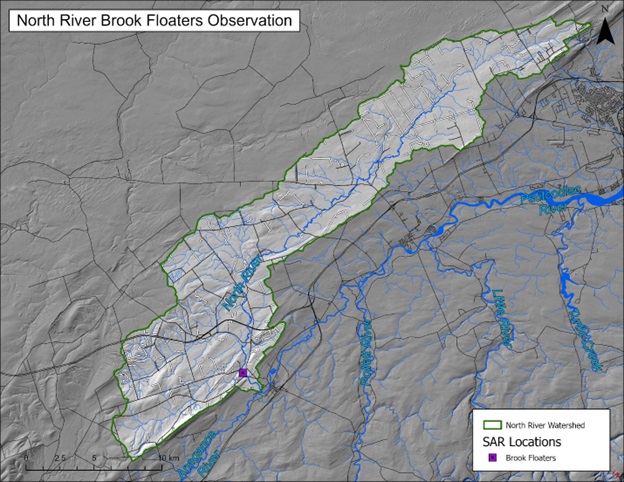Third Level Assessment – Aquatic and Riparian Habitat Assessment
Wildlife
Several species of wildlife that warrant specific attention either are or have been historically found within the North River watershed: Atlantic salmon, American eels, brook floaters, and wood turtles. Guidelines for projects in areas with these are in the Appendix.
Atlantic salmon (Salmo salar) Inner Bay of Fundy (iBoF) populations were listed as endangered under the Species at Risk Act in 2003 (DFO 2010; SARA Registry 2013a), and the species is considered extirpated from the Petitcodiac River system, except for those introduced in stocking programs (AMEC 2005). The decline in iBoF salmon is a marked contrast to the abundance described by early settlers (Dunfield 1991). Though numbers had been decreasing for some time (Elson 1962) construction of the causeway between Moncton and Riverview in 1968 complicated fish passage and extirpated the species from a river system that despite being 1 of 50 iBoF rivers, represented 20% of the total iBoF population (Locke, et al. 2003).
American eels (Anguilla rostrata) were designated as “Special Concern” by COSEWIC in 2006 (COSEWIC 2006). Their status was re-examined and raised to “Threatened” in May 2012 (COSEWIC 2014). This species is being considered for listing under the federal Species at Risk Act, but currently it has no status (SARA Registry 2013b).
Wood turtles (Glyptemys insculpta) were designated as “Special Concern” by COSEWIC in 1996 which was raised to “Threatened” in 2007 (COSEWIC 2007; COSEWIC 2011). This species is listed as “threatened” under the Species at Risk Act (SARA Registry 2012).
Brook floaters (Alasmidonta varicosa), are a medium sized species of freshwater mussel (Figure 7) listed as Special Concern by COSEWIC (COSEWIC 2009), and as Schedule 1, Special Concern, under the Species at Risk Act in 2013 (DFO 2016). Brook floaters were well documented along the main stem by DFO in the late 1990s (Hanson and Locke 2001). Their numbers appear to have declined since that time.

Brook floaters prefer clean running water with sand or sandy gravel substrates (Strayer and Ralley 1993; Nedeau et al. 2000) and are negatively impacted by increasing depth of fines (Baldigo et al. 2003) and turbidity (Strayer and Fetterman 1999). There is substantial evidence that sedimentation contributes to the decline of brook floater populations (DFO 2016).
The North River stood out in the late 1990s amongst the Petitcodiac tributaries surveyed by Hanson and Locke (2001) as almost devoid of all freshwater mussel species, due to habitat degradation associated with poor agricultural practices. That is consistent with what was seen by FFHR during follow up surveys roughly twenty years later in 2018. Brook floaters were only found at one site (just above the Glenvale bridge) at which Hanson and Locke had documented them (Figure 8). Two of Hanson and Locke’s sites on the North that declined in abundance classification for brook floaters from rare to none, were impressively poor in other mussel species as well. The site on the North River immediately above the mouth of the Anagance had only 19 mussels, none of which were brook floaters. Similarly, the North River site at Fawcett, immediately above the Highway 2 (Trans Canada) Bridges yielded only 1 mussel. Meanwhile, in 2018 sites elsewhere within the Petitcodiac regularly yielded hundreds of mussels of other species. Depending upon how few brook floaters had been seen at these North River sites in 1997-98, there may have been only a very slight change reflecting logical progression of trends already underway in the 1990s.
The distribution of the Species at Risk (SAR) within the North River watershed is presented in Figure 8. One conspicuous aspect of this figure is the lack of species other than brook floaters on it. While wood turtles have been encountered at several locations within the watershed while conducting other field work, due to their small home range, and vulnerability to poaching, encounters with wood turtles are considered to be sensitive information, and so are being withheld here.

Salmon and eels are another matter. Fort Folly Habitat Recovery has not encountered salmon in the course of its field work on the North River, likely due to the low numbers of this species within the system, and the North River not being their prime habitat. DFO has extensive records of interaction with salmon on the North River (Elson 1941). Eels have not been encountered by Fort Folly Habitat Recovery along the North River, due in part to the limited amount of electrofishing done there (two sites in 2012). However, historically they have been found in the North River watershed (Andrews 1943), and unlike salmon, eels were not excluded by the Moncton to Riverview Causeway downstream on the Petitcodiac. In fact, while the causeway gates were closed eels were found to be the most abundant resident species upstream of the headpond (Flanagan 2001), and one of the dominant species within the headpond (Locke et al 2000). Though there is no recent data available on eel numbers within the North River watershed, unlike salmon there is no reason to think that they are absent. Arguably this indicates that there might be value in undertaking work within the North River to address this knowledge gap.












